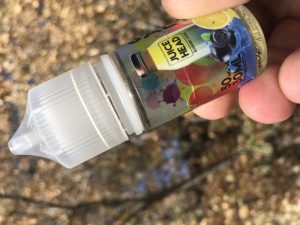E-cigarette illness count keeps climbing! Concern, not so much?
By Eric Valentine

Resort towns and rural states are not immune to epidemic. Disease doesn’t take vacations. But so far, only six cases of vaping-related illness, now called EVALI (E-cigarette or Vaping Associated Lung Injury), have been diagnosed in the Gem State. And according to staff at Smoking Dog Cigar Co. in Hailey, business there is doing just fine.
“It hasn’t affected us at all,” said Sal Wendland of Smoking Dog Cigar Co., especially after recent published articles indicated that black market cartridges that include THC were to blame for the uptick in serious lung issues and illnesses.
Wendland said many of the store’s customers vape to wean off of cigarettes, since it can give them a nicotine high without taking in the tar and other carcinogens found in traditional smoking of tobacco. And it’s this “benefit” of vaping that concerns health officials a lot.
“I’m concerned about the lack of concern,” said Cody Orchard, a health education specialist for South Central Public Health District. “Those six cases may not sound like a lot across an entire state, but that’s just within the last month or so. It is fair to say that we’re in the Wild West phase of this.”
Orchard, who teaches smoking cessation classes at Wood River High School and Wood River Middle School, among other Valley locations, points out that illnesses from traditional smoking emerged for smokers when they hit their 40s and 50s. Meanwhile, a large percentage of the illnesses today are being found in 15- to 35-year-olds.
“That’s supposed to be our young and healthy portion of the population. We don’t need that problem,” said Orchard. “What we’re seeing is pretty scary.”
The Scary Stuff
As of Oct. 8, 1,299 confirmed and probable lung injury cases associated with use of e-cigarette, or vaping, products were reported by 49 states, the District of Columbia, and the U.S. Virgin Islands, with 26 deaths being confirmed across 21 states, but not Idaho. The median age of patients who have died is 49 years, ranging from 17 to 75 years old.

If the numbers don’t alarm you, Orchard’s detailed explanations of why vaping is so popular may. First, there’s the weaning-off concept Wendland mentions. Yes, reducing tar and carcinogen is a positive. And if vaping can help anyone begin the cessation (quitting) process, that’s good news.
The problem, Orchard says, is what’s being discovered about today’s products—black market or otherwise. For instance, the liquid (sometimes called “vape juice”) that gets inhaled can contain vegetable glycerine. Sounds healthy, but when burned, it turns into acrolein—a toxic chemical found in Roundup.
“Everyone is using different products, from different places and different stores, so it’s really hard to know where the cause and the correlation is,” Orchard said.
And on this point, Wendland seems to agree.
“Europe has done a much better job researching this,” she said. “The information I go by is from overseas.”
Wendland noted that in Great Britain there have been enough government-approved studies that terms like “safer alternative to smoking” can be used. In the United States, that’s not allowed. Nicotine-based vaping sold in the states must contain labels that clearly state nicotine is addictive.
Some Solutions
For more information on EVALI and courses in the Valley, please visit phd5.idaho.gov/vaping or call the health district at (208) 737-5968.
The district holds courses from Twin Falls to the Wood River Valley, in schools and at St. Luke’s. The non-school courses are geared toward adults, but if parents call the district and ask for their teenage child to be in the class, teens are allowed.
When asked if there were one piece of information he wished everyone knew about the topic, Orchard said it’d be this: “People need to realize that the vaping product they smoked over a decade ago is probably not what they’re smoking today. This product has adapted in every way. There’s no smell. It looks like their thumb drive. It matches their phone. That’s part of what draws teens to it.”
[Box Out]:
Among 573 patients who used e-cigarette, or vaping, products in the 90 days prior to symptom onset:
- 76 percent reported using THC-containing products, with or without nicotine-containing products
- 58 percent reported using nicotine-containing products, with or without THC-containing products
- 32 percent reported exclusive use of THC-containing products
- 13 percent reported exclusive use of nicotine-containing products



